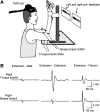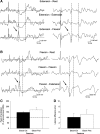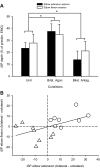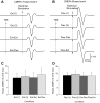Modulation of transcallosal inhibition by bilateral activation of agonist and antagonist proximal arm muscles
- PMID: 24155008
- PMCID: PMC3921387
- DOI: 10.1152/jn.00322.2013
Modulation of transcallosal inhibition by bilateral activation of agonist and antagonist proximal arm muscles
Abstract
Transcallosal inhibitory interactions between proximal representations in the primary motor cortex remain poorly understood. In this study, we used transcranial magnetic stimulation to examine the ipsilateral silent period (iSP; a measure of transcallosal inhibition) in the biceps and triceps brachii during unilateral and bilateral isometric voluntary contractions. Healthy volunteers performed 10% of maximal isometric voluntary elbow flexion or extension with one arm while the contralateral arm remained at rest or performed 30% of maximal isometric voluntary elbow flexion or extension. The iSP was measured in the arm performing 10% contractions, and electromyographic (EMG) recordings were comparable across conditions. The iSP onset and duration in the biceps and triceps brachii were comparable. In both muscles, the iSP depth and area were increased during bilateral contractions of homologous agonist muscles (extension-extension and flexion-flexion) compared with a unilateral contraction, whereas during bilateral contractions of nonhomologous antagonist muscles (extension-flexion and flexion-extension), the iSP depth and area were decreased compared with a unilateral contraction, and sometimes facilitation of EMG was seen. This effect was never observed during bilateral activation of homologous muscles. The size of responses evoked by cervicomedullary electrical stimulation in the arm that made 10% contractions remained unchanged across conditions. Thus transcallosal inhibition targeting triceps and biceps brachii is upregulated by voluntary contraction of the contralateral agonist muscle and downregulated by voluntary contraction of the contralateral antagonist muscle. We speculate that these reciprocal task-dependent interactions between bilateral flexor and extensor arm regions of the motor cortex may contribute to coupling between the arms during motor behavior.
Keywords: force; interhemispheric inhibition; primary motor cortex; transcallosal pathways; transcranial magnetic stimulation.
Figures






Similar articles
-
Crossed corticospinal facilitation between arm and trunk muscles in humans.J Neurophysiol. 2018 Nov 1;120(5):2595-2602. doi: 10.1152/jn.00178.2018. Epub 2018 May 30. J Neurophysiol. 2018. PMID: 29847230 Free PMC article.
-
Physiological changes underlying bilateral isometric arm voluntary contractions in healthy humans.J Neurophysiol. 2011 Apr;105(4):1594-602. doi: 10.1152/jn.00678.2010. Epub 2011 Jan 27. J Neurophysiol. 2011. PMID: 21273315 Free PMC article. Clinical Trial.
-
Enhanced inhibitory input to triceps brachii in humans with spinal cord injury.J Physiol. 2024 Dec;602(24):6909-6923. doi: 10.1113/JP285510. Epub 2024 Nov 6. J Physiol. 2024. PMID: 39504123
-
Selective activation of ipsilateral motor pathways in intact humans.J Neurosci. 2014 Oct 15;34(42):13924-34. doi: 10.1523/JNEUROSCI.1648-14.2014. J Neurosci. 2014. PMID: 25319689 Free PMC article. Clinical Trial.
-
The origin of activity in the biceps brachii muscle during voluntary contractions of the contralateral elbow flexor muscles.Exp Brain Res. 2006 Nov;175(3):526-35. doi: 10.1007/s00221-006-0570-z. Epub 2006 Aug 22. Exp Brain Res. 2006. PMID: 16924489
Cited by
-
E.L., a modern-day Phineas Gage: Revisiting frontal lobe injury.Lancet Reg Health Am. 2022 Aug 11;14:100340. doi: 10.1016/j.lana.2022.100340. eCollection 2022 Oct. Lancet Reg Health Am. 2022. PMID: 36777390 Free PMC article.
-
Crossed corticospinal facilitation between arm and trunk muscles in humans.J Neurophysiol. 2018 Nov 1;120(5):2595-2602. doi: 10.1152/jn.00178.2018. Epub 2018 May 30. J Neurophysiol. 2018. PMID: 29847230 Free PMC article.
-
Neural motor control differs between bimanual common-goal vs. bimanual dual-goal tasks.Exp Brain Res. 2018 Jun;236(6):1789-1800. doi: 10.1007/s00221-018-5261-z. Epub 2018 Apr 16. Exp Brain Res. 2018. PMID: 29663024
-
Unilateral movement preparation causes task-specific modulation of TMS responses in the passive, opposite limb.J Physiol. 2018 Aug;596(16):3725-3738. doi: 10.1113/JP275433. Epub 2018 Jun 19. J Physiol. 2018. PMID: 29775218 Free PMC article.
-
The distribution of transcallosal inhibition to upper extremity muscles is altered in chronic stroke.J Neurol Sci. 2023 Jul 15;450:120688. doi: 10.1016/j.jns.2023.120688. Epub 2023 May 13. J Neurol Sci. 2023. PMID: 37224604 Free PMC article.
References
-
- Bäumer T, Dammann E, Bock F, Klöppel S, Siebner HR, Münchau A. Laterality of interhemispheric inhibition depends on handedness. Exp Brain Res 180:195–203, 2007 - PubMed
-
- Bawa P, Hamm JD, Dhillon P, Gross PA. Bilateral responses of upper limb muscles to transcranial magnetic stimulation in human subjects. Exp Brain Res 158: 385–390, 2004 - PubMed
Publication types
MeSH terms
Grants and funding
LinkOut - more resources
Full Text Sources
Other Literature Sources

